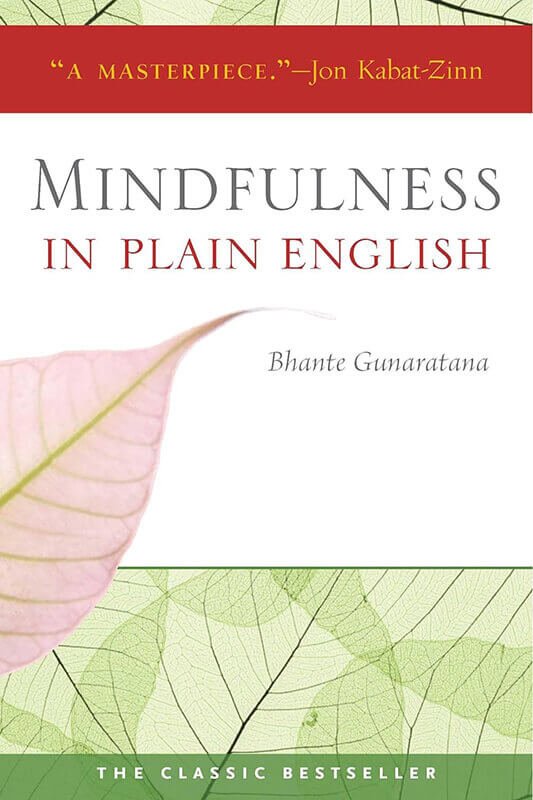In the vast sea of mindfulness literature, “Mindfulness in Plain English” by Bhante Henepola Gunaratana stands out as a beacon of clarity and wisdom. First published in 1994 and revised in 2011, this book has become a classic in the field of meditation and mindfulness practice.
Gunaratana, a Buddhist monk with over 50 years of teaching experience, offers a comprehensive, accessible guide to Vipassana meditation, demystifying the practice and providing practical tools for cultivating mindfulness in everyday life.
Core Concepts
At its heart, “Mindfulness in Plain English” introduces and explores several key ideas:
- The nature of mindfulness and its benefits
- The practice of Vipassana (insight) meditation
- Common obstacles in meditation and how to overcome them
- The role of mindfulness in daily life
- The path to deeper understanding and inner peace
Through these concepts, Gunaratana provides a roadmap for readers to develop a robust mindfulness practice, leading to greater clarity, peace, and self-awareness.
Chapter-by-Chapter Review
Chapters 1–3: Understanding Meditation
These chapters introduce meditation, addressing why it matters, what it isn’t, and what it truly is. Gunaratana emphasizes that meditation is more than relaxation or escaping life’s pressures; it is a disciplined practice that cultivates clarity, calmness, and insight. By debunking misconceptions and clarifying the purpose, these chapters provide a strong foundation for anyone beginning their meditation journey.
Chapter 4: Cultivating the Right Attitude
Chapter 4 emphasizes the mindset needed for successful meditation. Patience, persistence, non-judgment, and self-compassion are essential qualities for sustaining practice and handling challenges without frustration.
Chapters 5–9: Practical Meditation Techniques
The middle section of the book is a hands-on guide to practicing meditation. Gunaratana details body posture, clothing, and traditional seated positions, alongside mental discipline and attention training. He provides instructions on structuring meditation sessions, choosing where and when to sit, and establishing duration. Preparatory exercises, including threefold guidance and loving-kindness practices, offer practical tools to anchor the mind and cultivate a stable, focused meditation practice.
Chapters 10–12: Managing Challenges
These chapters tackle common obstacles in meditation, such as restlessness, sleepiness, pain, and mental distractions. Gunaratana explains strategies for recognizing and redirecting wandering thoughts, handling emotional reactions, and maintaining steady attention. This section equips readers with practical techniques to sustain meditation even under challenging conditions, emphasizing resilience and mindfulness in the face of difficulties.
Chapters 13–14: Deepening Mindfulness
Gunaratana explores the core principles of mindfulness (Sati), explaining its role in observing thoughts, emotions, and sensations with clarity. The distinction between mindfulness and concentration is clarified, showing how awareness and focus complement each other in meditation. These chapters highlight the transformative potential of mindfulness, emphasizing insight and understanding as outcomes of consistent practice.
Chapters 15–16: Integrating Mindfulness into Daily Life
The final chapters show how mindfulness can be applied beyond formal practice, enhancing emotional regulation, relationships, and overall well-being, and reinforcing the lifelong benefits of meditation.
Key Strengths
- Clear, accessible language that truly lives up to the “Plain English” title
- Comprehensive coverage of mindfulness and meditation concepts
- Practical, step-by-step instructions for developing a meditation practice
- Addresses common obstacles and misconceptions about meditation
- Balances theoretical knowledge with practical application
Potential Drawbacks
- Some readers may find the Buddhist terminology unfamiliar
- The depth of information might be overwhelming for complete beginners
- Those seeking a quick-fix solution may find the emphasis on consistent practice challenging
Who This Book Is For
“Mindfulness in Plain English” is particularly valuable for:
- Beginners looking for a comprehensive introduction to mindfulness and meditation
- Experienced practitioners seeking to deepen their understanding and practice
- Individuals dealing with stress, anxiety, or seeking greater peace of mind
- Anyone interested in the intersection of Buddhist philosophy and practical life skills
Final Review
“Mindfulness in Plain English” lives up to its title, offering a clear, accessible guide to mindfulness and meditation. Gunaratana’s writing style is straightforward and engaging, making complex concepts easy to grasp without oversimplifying them.
The book’s strength lies in its balance of theory and practice. Readers gain a solid understanding of the principles behind mindfulness while receiving practical guidance on how to implement these ideas in their daily lives. Gunaratana’s compassionate tone and wealth of experience shine through, providing encouragement and inspiration throughout the book.
While the wealth of information might be overwhelming for some, the book is structured in a way that allows readers to progress at their own pace. The emphasis on consistent practice and patience is refreshing in a world often seeking quick fixes.
Rating: 4.7/5
An essential guide for anyone serious about developing a mindfulness practice, “Mindfulness in Plain English” offers a clear path to greater awareness, inner peace, and personal growth.

Alternative Books
If you are looking for other books like “Mindfulness in Plain English”, consider these alternatives:

“The Power of Now” by Eckhart Tolle
Offers another perspective on present-moment awareness and spiritual enlightenment.
Rating: 4.6/5

“10% Happier” by Dan Harris
Provides a skeptic’s journey into meditation, offering a relatable approach for those new to mindfulness.
Rating: 4.4/5

“The Book of Joy” by Dalai Lama and Desmond Tutu
Explores the nature of true joy and how to cultivate it, complementing the mindfulness practices in Gunaratana’s book.
Rating: 4.8/5





